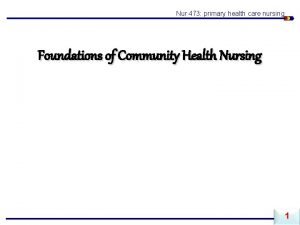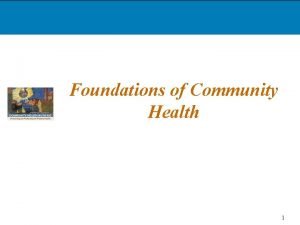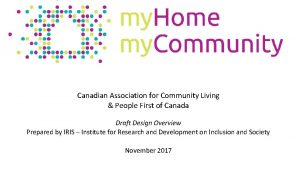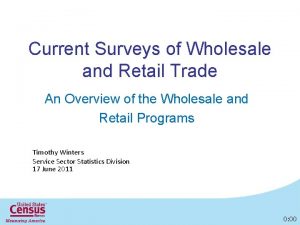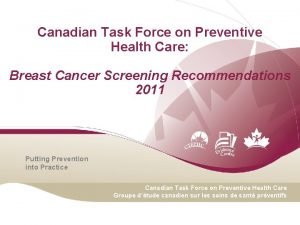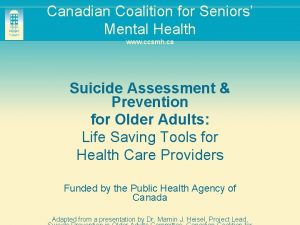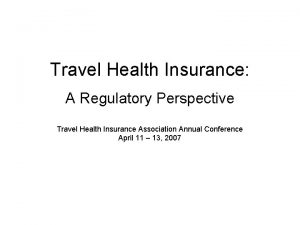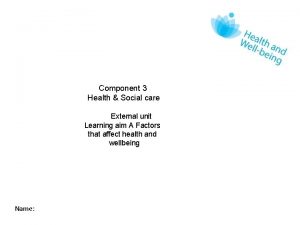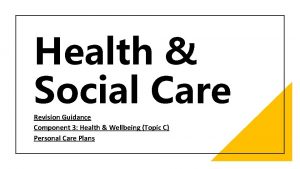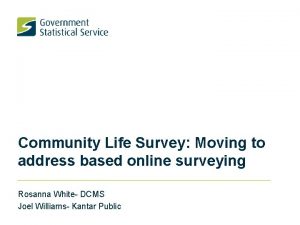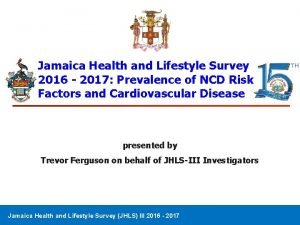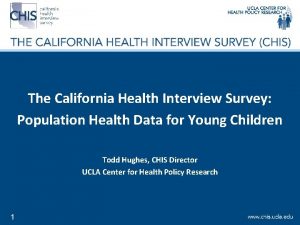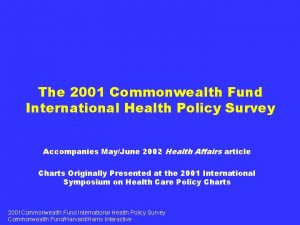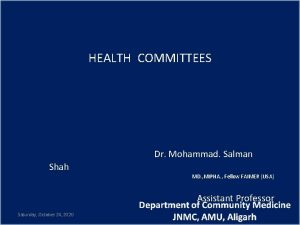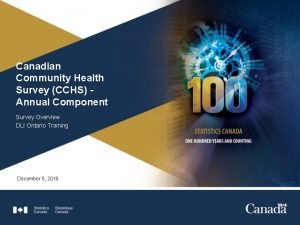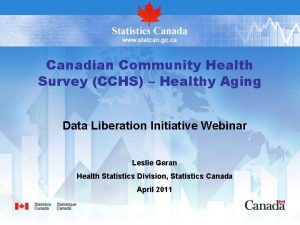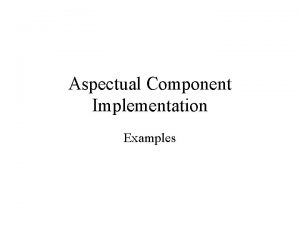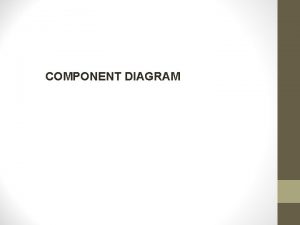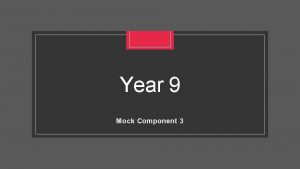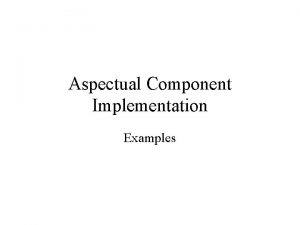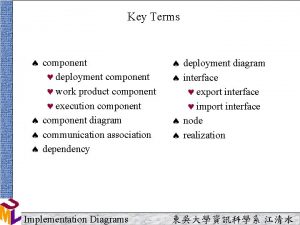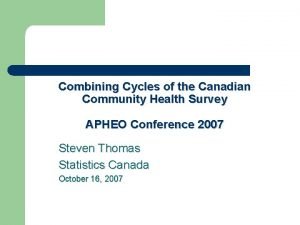Canadian Community Health Survey CCHS Annual Component Survey


























- Slides: 26

Canadian Community Health Survey (CCHS) - Annual Component Survey Overview - DLI Halifax Training May 9 th, 2019

Overview • • • Survey Overview Content overview through the years Important changes about 2015 redesign 2015 -16 CCHS PUMF 1 Future modernizations 1 – Public Use Microdata File

Survey overview - history • Started with Health Information Roadmap -1999 • Adoption of an indicator framework • • • Health behaviours Health surveillance Access to health care system • CCHS annual program and focus content program • Governing committee – Canadian Population Health Survey Program • Health Canada, Public Health Agency of Canada • Expert groups 3

Survey Overview - Objectives • Health surveillance at the national, provincial and sub-provincial levels • Analysis on small populations and rare characteristics • Readily available data to a diversified user community in a timely fashion • Flexible survey instrument 4

Survey Overview: Design • Residents of private households aged 12 and over • Exclusions: • Aboriginal reserves / settlements • institutions (health institutions, prisons, religious institutions, convents, etc. ) • members of Canadian Forces • Residents of certain very remote areas • Coverage (general) ~97% of targeted population • Designed to provide reliable estimates at the health region level with two years of data 5

Survey overview: Health Regions • Administration of health in the provinces is divided into health regions. • PEI and territories each are designated as their own single HR • For CCHS 2015 -2016, data was collected for 104 HRs in the provinces, in PEI and in each territory, totalling 108 HRs • This is the lowest level of geography on the PUMF, after some grouping* 6

Survey overview: Collection • The CCHS is collected by interviewers using a computer based questionnaire: • 20% in person, and • 80% by telephone • Respondents aged 12 -15 interviewed alone with parental consent • 2. 5% of cases completed by proxy 7

Survey overview: Data processing • During the interview, questions get skipped for various reasons and need coding: • Non-response • Interview incomplete • Question not relevant These cases are coded as “Not stated” Coded as “Not applicable” • “Other – specify” responses are sometimes recoded to a response category • Derived variables are added to the file based on responses 8

Survey overview: Weighting • Each respondent represents themselves and others in the population • The sample weight WTS_M indicates the population represented by each respondent • Weights have been adjusted for nonresponse and calibrated to match population estimates: HR*sex*age group 9

Survey overview - content • Three main types of content in survey • Core: all years, all respondents • Theme: certain years, all respondents • Optional: certain years, certain provinces/territories • Other content not available through DLI: • Buy-ins • Rapid responses • Sub-samples 10

Survey overview – content plan 11

12

13

14

CCHS Redesign of 2015 • Frame changes • Household survey frame for adults • CCB for youth 12 -17 • Collection methods • More telephone interviews overall (incl. for all youth respondents) • Sample allocation more responsive to change • Territorial coverage only over 2 -years 15

CCHS - PUMF details • Previous two year PUMFs: • • Cycle 1. 1 (2000/2001) Cycle 2. 1 (2002/2003) Cycle 3. 1 (2004/2005) 2007/2008 2009/2010 2011/2012 2013/2014 2015/2016 • Previous one year PUMFs: • 2010 • 2012 • 2014 16

Included core content for CCHS 2015 -2016 PUMF § Alcohol Use § Chronic Conditions § Contact with health professionals § Exposure to Secondhand Smoke § Flu Shots § Fruit and Vegetable Consumption § General Health § Height and Weight § Physical Activities for adults/youth § Primary Health Care Providers § Smoking § Maternal experiences § Administration § Age § Labour Force § Main occupation § Socio-demographics 17

Included theme content for CCHS 2015 -2016 PUMF • Health behaviours • Alcohol past week • Drug methods* • Sexual behaviours* • Patient experience • Insurance • Patient experience • Home care* • Mental health • Consultation about mental health • Suicidal thoughts and attempts* • Health conditions • Chronic conditions • Theme 1 18

Design for CCHS PUMF • 2015/16 PUMF contains 109, 659 records • 1, 199 variables • Geography variables • Province / territory of dwelling* • Health region of dwelling (grouped) • Canadian Active Living Environment (CANALE) 19

Canadian Active Living Environnent (CANALE) • New variable for CCHS PUMF • Provides additional geospatial value to the file • Scores (1 -5) each 2016 DA based on the active living environment (intersection/dwelling density, points of interest, and transit stops). • To link to CCHS, 2011 DAs from the file were linked with 2016 DAs in CANALE file. Multiple matches were dealt with random selection proportional to population size. • Included in pre-masking to prevent ungrouping of HRs 20

CCHS PUMF – disclosure control • Geography / HR population size • Minimum population size of 70, 000 per health region § 19 HRs grouped into 9 § 3 Territories not grouped this PUMF • Results in 98 Health Regions or HR groupings • Age of respondent • 5 year age groups 20 -24 -> 75 -79 • 12 -14, 15 -17, 18 -19 § Supports research on Body Mass Index (BMI) and new physical activity content (PAA/PAY) • Other indirect identifiers grouped or masked to prevent disclosure 21

CCHS 15 -16 PUMF: Poisson bootstrap weights • Previous PUMFs did not include bootstrap weights • 2015 -2016 PUMF includes Poisson bootstrap weights • Each weight for each replicate is generated independently • All bootstrap weights are strictly positive • The Poisson bootstrap does not pose confidentiality concerns 22

PUMF Package • Data • Bootstrap weights • Documentation • • • User guides CV tables Data Dictionary Derived Variables Errata Questionnaire • Beyond 2020 23

2021 CCHS Redesign Objectives • Transition to Electronic Questionnaires • Revisit content and develop a new content plan • Revisit the methodology • Increase administrative data holdings • Modernize with Statistics Canada • 2020 Pilot 24

CCHS-Annual Contacts • Content manager: Anne-Marie Vinette • Anne-Marie. Vinette@canada. ca • Dissemination Manager: Shawn Brule • Shawn. Brule@canada. ca • Collection Manager: Bernard Paquet • Bernard. Paquet@canada. ca • Project Manager: Amanda Wright • Amanda. Wright@canada. ca • Redesign Manager: Ed Rama • Ed. Rama@canada. ca • Section Chief: José Gaudet • Jose. Gaudet@canada. ca 25

THANK YOU! For more information, please visit www. statcan. gc. ca #Stat. Can 100
 Cchs 165
Cchs 165 Components of community health nursing
Components of community health nursing Characteristics of community health nursing
Characteristics of community health nursing Health and social care component 3 health and wellbeing
Health and social care component 3 health and wellbeing Canadian community economic development network
Canadian community economic development network Canadian association for community living
Canadian association for community living Ciip canada
Ciip canada Annual wholesale trade survey
Annual wholesale trade survey Role of occupational health nurse
Role of occupational health nurse Ctfphc
Ctfphc Canadian coalition for seniors mental health
Canadian coalition for seniors mental health Travel health insurance association annual conference
Travel health insurance association annual conference Btec
Btec Health and social care component 2 learning aim b example
Health and social care component 2 learning aim b example Component of health assessment
Component of health assessment Component 3 health and wellbeing
Component 3 health and wellbeing Ample abcde
Ample abcde Community right to know survey nj
Community right to know survey nj Community life survey
Community life survey Prepare to scale up in social mobilization
Prepare to scale up in social mobilization Jamaica health and lifestyle survey
Jamaica health and lifestyle survey Ehis eurostat
Ehis eurostat California health information survey
California health information survey Commonwealth fund international health policy survey
Commonwealth fund international health policy survey Medicare health outcomes survey
Medicare health outcomes survey European health literacy survey
European health literacy survey Mukherjee committee 1966
Mukherjee committee 1966

